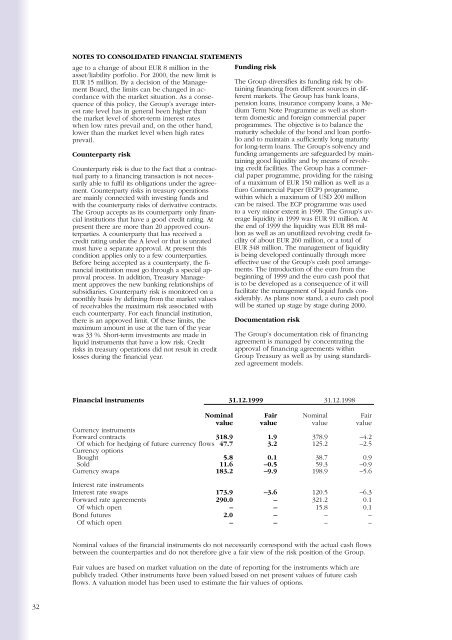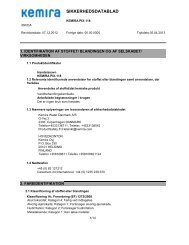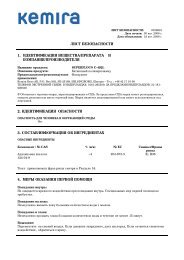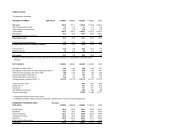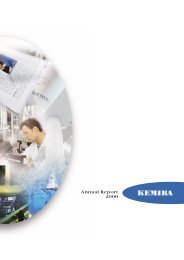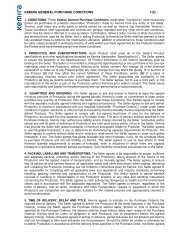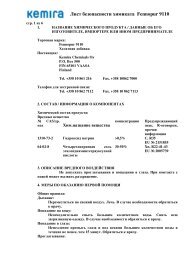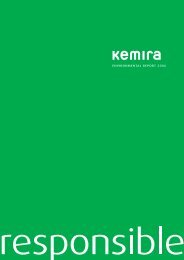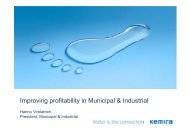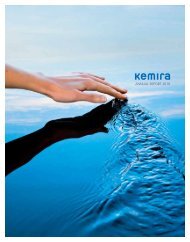Annual Report 1999 - Kemira
Annual Report 1999 - Kemira
Annual Report 1999 - Kemira
You also want an ePaper? Increase the reach of your titles
YUMPU automatically turns print PDFs into web optimized ePapers that Google loves.
NOTES TO CONSOLIDATED FINANCIAL STATEMENTS<br />
age to a change of about EUR 8 million in the<br />
asset/liability porfolio. For 2000, the new limit is<br />
EUR 15 million. By a decision of the Management<br />
Board, the limits can be changed in accordance<br />
with the market situation. As a consequence<br />
of this policy, the Group’s average interest<br />
rate level has in general been higher than<br />
the market level of short-term interest rates<br />
when low rates prevail and, on the other hand,<br />
lower than the market level when high rates<br />
prevail.<br />
Counterparty risk<br />
Counterparty risk is due to the fact that a contractual<br />
party to a financing transaction is not necessarily<br />
able to fulfil its obligations under the agreement.<br />
Counterparty risks in treasury operations<br />
are mainly connected with investing funds and<br />
with the counterparty risks of derivative contracts.<br />
The Group accepts as its counterparty only financial<br />
institutions that have a good credit rating. At<br />
present there are more than 20 approved counterparties.<br />
A counterparty that has received a<br />
credit rating under the A level or that is unrated<br />
must have a separate approval. At present this<br />
condition applies only to a few counterparties.<br />
Before being accepted as a counterparty, the financial<br />
institution must go through a special approval<br />
process. In addition, Treasury Management<br />
approves the new banking relationships of<br />
subsidiaries. Counterparty risk is monitored on a<br />
monthly basis by defining from the market values<br />
of receivables the maximum risk associated with<br />
each counterparty. For each financial institution,<br />
there is an approved limit. Of these limits, the<br />
maximum amount in use at the turn of the year<br />
was 33 %. Short-term investments are made in<br />
liquid instruments that have a low risk. Credit<br />
risks in treasury operations did not result in credit<br />
losses during the financial year.<br />
Funding risk<br />
The Group diversifies its funding risk by obtaining<br />
financing from different sources in different<br />
markets. The Group has bank loans,<br />
pension loans, insurance company loans, a Medium<br />
Term Note Programme as well as shortterm<br />
domestic and foreign commercial paper<br />
programmes. The objective is to balance the<br />
maturity schedule of the bond and loan portfolio<br />
and to maintain a sufficiently long maturity<br />
for long-term loans. The Group’s solvency and<br />
funding arrangements are safeguarded by maintaining<br />
good liquidity and by means of revolving<br />
credit facilities. The Group has a commercial<br />
paper programme, providing for the raising<br />
of a maximum of EUR 150 million as well as a<br />
Euro Commercial Paper (ECP) programme,<br />
within which a maximum of USD 200 million<br />
can be raised. The ECP programme was used<br />
to a very minor extent in <strong>1999</strong>. The Group’s average<br />
liquidity in <strong>1999</strong> was EUR 91 million. At<br />
the end of <strong>1999</strong> the liquidity was EUR 88 million<br />
as well as an unutilized revolving credit facility<br />
of about EUR 260 million, or a total of<br />
EUR 348 million. The management of liquidity<br />
is being developed continually through more<br />
effective use of the Group’s cash pool arrangements.<br />
The introduction of the euro from the<br />
beginning of <strong>1999</strong> and the euro cash pool that<br />
is to be developed as a consequence of it will<br />
facilitate the management of liquid funds considerably.<br />
As plans now stand, a euro cash pool<br />
will be started up stage by stage during 2000.<br />
Documentation risk<br />
The Group’s documentation risk of financing<br />
agreement is managed by concentrating the<br />
approval of financing agreements within<br />
Group Treasury as well as by using standardized<br />
agreement models.<br />
Financial instruments 31.12.<strong>1999</strong> 31.12.1998<br />
Nominal Fair Nominal Fair<br />
value value value value<br />
Currency instruments<br />
Forward contracts 318.9 1.9 378.9 –4.2<br />
Of which for hedging of future currency flows 47.7 3.2 125.2 –2.5<br />
Currency options<br />
Bought 5.8 0.1 38.7 0.9<br />
Sold 11.6 –0.5 59.3 –0.9<br />
Currency swaps 183.2 –9.9 198.9 –5.6<br />
Interest rate instruments<br />
Interest rate swaps 173.9 –3.6 120.5 –6.3<br />
Forward rate agreements 290.0 – 321.2 0.1<br />
Of which open – – 15.8 0.1<br />
Bond futures 2.0 – – –<br />
Of which open – – – –<br />
Nominal values of the financial instruments do not necessarily correspond with the actual cash flows<br />
between the counterparties and do not therefore give a fair view of the risk position of the Group.<br />
Fair values are based on market valuation on the date of reporting for the instruments which are<br />
publicly traded. Other instruments have been valued based on net present values of future cash<br />
flows. A valuation model has been used to estimate the fair values of options.<br />
32


